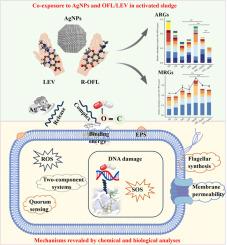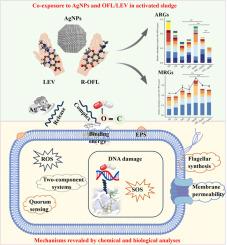银纳米粒子与手性抗生素的对映选择性相互作用驱动活性污泥的耐药性演变
IF 12.4
1区 环境科学与生态学
Q1 ENGINEERING, ENVIRONMENTAL
引用次数: 0
摘要
抗生素的立体化学会显著影响耐药性的发展。随着抗生素耐药性的增加,纳米技术正在成为一种有希望的解决方案,潜在地增加了纳米颗粒与废水处理厂(WWTPs)抗生素共存的可能性。然而,纳米颗粒对手性抗生素诱导耐药的影响尚不清楚。本研究采用化学表征、宏基因组学、分子对接等方法,全面阐明银纳米颗粒(AgNPs)与手性抗生素(氧氟沙星:OFL、左氧氟沙星:LEV)联合耐药的机制。AgNPs显著改变了抗生素和金属抗性基因的丰度和组成,以及RP4质粒在活性污泥群落之间的共轭转移,其中OFL_AgNPs组合表现出比LEV_AgNPs更高的抗性潜力。机制研究表明,手性抗生素选择性地与AgNPs相互作用,促进Ag+释放,增强抗生素摄取,形成稳定的配合物。这些相互作用重塑了微生物的功能,包括细胞膜渗透性、氧化应激反应、群体感应和细胞外分泌,从而塑造了抗性谱。这项研究揭示了以前被忽视的与纳米颗粒-抗生素相互作用相关的对映体特异性风险,并为减轻ARG在废水处理和更广泛的环境系统中的传播策略提供了基础。本文章由计算机程序翻译,如有差异,请以英文原文为准。


Enantioselective interactions of silver nanoparticles and chiral antibiotics in driving resistance evolution in activated sludge
The stereochemistry of antibiotics significantly affects resistance development. With rising antibiotic resistance, nanotechnology is emerging as a promising solution, potentially increasing the likelihood of nanoparticle coexistence with antibiotics in wastewater treatment plants (WWTPs). However, the influence of nanoparticles on chiral antibiotics induced resistance remains unclear. This study employed chemical characterization, metagenomics, and molecular docking to comprehensively elucidate the resistance mechanisms induced by the combination of silver nanoparticles (AgNPs) and chiral antibiotics (ofloxacin: OFL and levofloxacin: LEV). AgNPs significantly altered the abundance and composition of antibiotic and metal resistance genes, as well as the conjugative transfer of the RP4 plasmid among activated sludge communities, with the OFL_AgNPs combination exhibiting a higher resistance potential than LEV_AgNPs. Mechanistic studies revealed that chiral antibiotics selectively interact with AgNPs, promoting Ag⁺ release, enhancing antibiotic uptake, and forming stable complexes. These interactions reshaped microbial functions, including cell membrane permeability, oxidative stress response, quorum sensing, and extracellular secretion, thereby shaping resistance profiles. This study reveals previously overlooked enantiomer-specific risks associated with nanoparticle-antibiotic interactions and provides a foundation for strategies to mitigate ARG dissemination in wastewater treatment and broader environmental systems.
求助全文
通过发布文献求助,成功后即可免费获取论文全文。
去求助
来源期刊

Water Research
环境科学-工程:环境
CiteScore
20.80
自引率
9.40%
发文量
1307
审稿时长
38 days
期刊介绍:
Water Research, along with its open access companion journal Water Research X, serves as a platform for publishing original research papers covering various aspects of the science and technology related to the anthropogenic water cycle, water quality, and its management worldwide. The audience targeted by the journal comprises biologists, chemical engineers, chemists, civil engineers, environmental engineers, limnologists, and microbiologists. The scope of the journal include:
•Treatment processes for water and wastewaters (municipal, agricultural, industrial, and on-site treatment), including resource recovery and residuals management;
•Urban hydrology including sewer systems, stormwater management, and green infrastructure;
•Drinking water treatment and distribution;
•Potable and non-potable water reuse;
•Sanitation, public health, and risk assessment;
•Anaerobic digestion, solid and hazardous waste management, including source characterization and the effects and control of leachates and gaseous emissions;
•Contaminants (chemical, microbial, anthropogenic particles such as nanoparticles or microplastics) and related water quality sensing, monitoring, fate, and assessment;
•Anthropogenic impacts on inland, tidal, coastal and urban waters, focusing on surface and ground waters, and point and non-point sources of pollution;
•Environmental restoration, linked to surface water, groundwater and groundwater remediation;
•Analysis of the interfaces between sediments and water, and between water and atmosphere, focusing specifically on anthropogenic impacts;
•Mathematical modelling, systems analysis, machine learning, and beneficial use of big data related to the anthropogenic water cycle;
•Socio-economic, policy, and regulations studies.
 求助内容:
求助内容: 应助结果提醒方式:
应助结果提醒方式:


